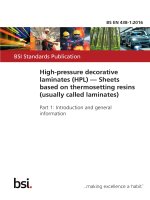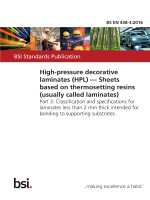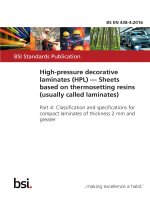Bsi bs en 62087 4 2016
Bạn đang xem bản rút gọn của tài liệu. Xem và tải ngay bản đầy đủ của tài liệu tại đây (990.77 KB, 22 trang )
BS EN 62087-4:2016
BSI Standards Publication
Audio, video and related
equipment — Determination
of power consumption
Part 4: Video recording equipment
BS EN 62087-4:2016
BRITISH STANDARD
National foreword
This British Standard is the UK implementation of EN 62087-4:2016. It is
identical to IEC 62087-4:2015. Together with BS EN 62087-1:2016,
BS EN 62087-2, BS EN 62087-3:2016, BS EN 62087-5:2016 and
BS EN 62087-6:2015 it supersedes BS EN 62087:2012 which will be
withdrawn on 19 February 2019.
The UK participation in its preparation was entrusted to Technical
Committee EPL/100, Audio, video and multimedia systems and equipment.
A list of organizations represented on this committee can be obtained
on request to its secretary.
This publication does not purport to include all the necessary provisions
of a contract. Users are responsible for its correct application.
© The British Standards Institution 2016.
Published by BSI Standards Limited 2016
ISBN 978 0 580 82956 7
ICS 33.160.10
Compliance with a British Standard cannot confer immunity from
legal obligations.
This British Standard was published under the authority of the Standards
Policy and Strategy Committee on 30 April 2016.
Amendments/corrigenda issued since publication
Date
Text affected
BS EN 62087-4:2016
EUROPEAN STANDARD
EN 62087-4
NORME EUROPÉENNE
EUROPÄISCHE NORM
February 2016
ICS 33.160.10
Supersedes EN 62087:2012 (partially)
English Version
Audio, video and related equipment - Determination of power
consumption - Part 4: Video recording equipment
(IEC 62087-4:2015)
Appareils audio, vidéo et matériel connexe - Détermination
de la consommation de puissance - Partie 4: Matériel
d'enregistrement vidéo
(IEC 62087-4:2015)
Messverfahren für die Leistungsaufnahme von Audio,
Video- und verwandten Geräten Teil 4: Videoaufzeichnungsgeräte
(IEC 62087-4:2015)
This European Standard was approved by CENELEC on 2015-07-10. CENELEC members are bound to comply with the CEN/CENELEC
Internal Regulations which stipulate the conditions for giving this European Standard the status of a national standard without any alteration.
Up-to-date lists and bibliographical references concerning such national standards may be obtained on application to the CEN-CENELEC
Management Centre or to any CENELEC member.
This European Standard exists in three official versions (English, French, German). A version in any other language made by translation
under the responsibility of a CENELEC member into its own language and notified to the CEN-CENELEC Management Centre has the
same status as the official versions.
CENELEC members are the national electrotechnical committees of Austria, Belgium, Bulgaria, Croatia, Cyprus, the Czech Republic,
Denmark, Estonia, Finland, Former Yugoslav Republic of Macedonia, France, Germany, Greece, Hungary, Iceland, Ireland, Italy, Latvia,
Lithuania, Luxembourg, Malta, the Netherlands, Norway, Poland, Portugal, Romania, Slovakia, Slovenia, Spain, Sweden, Switzerland,
Turkey and the United Kingdom.
European Committee for Electrotechnical Standardization
Comité Européen de Normalisation Electrotechnique
Europäisches Komitee für Elektrotechnische Normung
CEN-CENELEC Management Centre: Avenue Marnix 17, B-1000 Brussels
© 2016 CENELEC All rights of exploitation in any form and by any means reserved worldwide for CENELEC Members.
Ref. No. EN 62087-4:2016 E
BS EN 62087-4:2016
EN 62087-4:2016
European foreword
The text of document 100/2469/FDIS, future edition 1 of IEC 62087-4, prepared by Technical Area 12
“AV energy efficiency and smart grid applications” of IEC/TC 100 “Audio, video and multimedia
systems and equipment” was submitted to the IEC-CENELEC parallel vote and approved by
CENELEC as EN 62087-4:2016.
The following dates are fixed:
•
latest date by which the document has to be
implemented at national level by
publication of an identical national
standard or by endorsement
(dop)
2016-08-19
•
latest date by which the national
standards conflicting with the
document have to be withdrawn
(dow)
2019-02-19
This document supersedes EN 62087:2012 (partially).
Attention is drawn to the possibility that some of the elements of this document may be the subject of
patent rights. CENELEC [and/or CEN] shall not be held responsible for identifying any or all such
patent rights.
Endorsement notice
The text of the International Standard IEC 62087-4:2015 was approved by CENELEC as a European
Standard without any modification.
In the official version, for Bibliography, the following notes have to be added for the standards indicated:
ii2
IEC 61938:2013
NOTE
Harmonized as EN 61938:2013 (not modified).
IEC 62087 Series
NOTE
Harmonized as EN 62087 Series.
IEC 62087-2:2015
NOTE
Harmonized as EN 62087-2:2015 (not modified).
IEC 62301:2011
NOTE
Harmonized as EN 50564:2011 (modified).
IEC 62542:2013
NOTE
Harmonized as EN 62542:2013 (not modified).
BS EN 62087-4:2016
EN 62087-4:2016
Annex ZA
(normative)
Normative references to international publications
with their corresponding European publications
The following documents, in whole or in part, are normatively referenced in this document and are
indispensable for its application. For dated references, only the edition cited applies. For undated
references, the latest edition of the referenced document (including any amendments) applies.
NOTE 1 When an International Publication has been modified by common modifications, indicated by (mod), the relevant
EN/HD applies.
NOTE 2 Up-to-date information on the latest versions of the European Standards listed in this annex is available here:
www.cenelec.eu
Publication
Year
Title
EN/HD
Year
IEC 60107-1
1997
Methods of measurement on receivers
for television broadcast transmissions Part 1: General considerations Measurements at radio and video
frequencies
EN 60107-1
1997
IEC 62087-1
2015
Audio, video, and related equipment Determination of power consumption Part 1: General
EN 62087-1
2016
IEC 62216
2009
Digital terrestrial television receivers
for the DVB-T system
EN 62216
2011
iii
3
–2–
BS EN 62087-4:2016
IEC 62087-4:2015 © IEC 2015
CONTENTS
FOREWORD ........................................................................................................................... 3
INTRODUCTION ..................................................................................................................... 5
1
Scope .............................................................................................................................. 6
2
Normative references ...................................................................................................... 6
3
Terms, definitions and abbreviations ............................................................................... 6
3.1
Terms and definitions .............................................................................................. 6
3.2
Abbreviations .......................................................................................................... 7
4
Specification of operating modes and functions ............................................................... 7
4.1
General ................................................................................................................... 7
4.2
Auto power down function ....................................................................................... 8
5
Measuring conditions for video recorders ......................................................................... 9
5.1
Input signal ............................................................................................................. 9
5.1.1
General ........................................................................................................... 9
5.1.2
RF test signal .................................................................................................. 9
5.1.3
Broadband input signal .................................................................................... 9
5.2
Input terminals ........................................................................................................ 9
5.2.1
Analogue terrestrial input terminal ................................................................... 9
5.2.2
Cable television input terminal ....................................................................... 10
5.2.3
Digital terrestrial input terminal ...................................................................... 10
5.2.4
Satellite input terminal ................................................................................... 10
5.3
Measurement procedure ....................................................................................... 10
5.3.1
General measuring conditions ....................................................................... 10
5.3.2
Stabilization ................................................................................................... 10
5.3.3
Environmental conditions ............................................................................... 10
5.3.4
Setup ............................................................................................................. 10
5.3.5
Power measurements .................................................................................... 11
Bibliography .......................................................................................................................... 15
Figure 1 – Auto power down function .................................................................................... 14
Table 1 – Operating modes and functions ............................................................................... 8
Table 2 – Matrix for multituner VRs ....................................................................................... 12
BS EN 62087-4:2016
IEC 62087-4:2015 © IEC 2015
–3–
INTERNATIONAL ELECTROTECHNICAL COMMISSION
____________
AUDIO, VIDEO AND RELATED EQUIPMENT –
DETERMINATION OF POWER CONSUMPTION –
Part 4: Video recording equipment
FOREWORD
1) The International Electrotechnical Commission (IEC) is a worldwide organization for standardization comprising
all national electrotechnical committees (IEC National Committees). The object of IEC is to promote
international co-operation on all questions concerning standardization in the electrical and electronic fields. To
this end and in addition to other activities, IEC publishes International Standards, Technical Specifications,
Technical Reports, Publicly Available Specifications (PAS) and Guides (hereafter referred to as “IEC
Publication(s)”). Their preparation is entrusted to technical committees; any IEC National Committee interested
in the subject dealt with may participate in this preparatory work. International, governmental and nongovernmental organizations liaising with the IEC also participate in this preparation. IEC collaborates closely
with the International Organization for Standardization (ISO) in accordance with conditions determined by
agreement between the two organizations.
2) The formal decisions or agreements of IEC on technical matters express, as nearly as possible, an international
consensus of opinion on the relevant subjects since each technical committee has representation from all
interested IEC National Committees.
3) IEC Publications have the form of recommendations for international use and are accepted by IEC National
Committees in that sense. While all reasonable efforts are made to ensure that the technical content of IEC
Publications is accurate, IEC cannot be held responsible for the way in which they are used or for any
misinterpretation by any end user.
4) In order to promote international uniformity, IEC National Committees undertake to apply IEC Publications
transparently to the maximum extent possible in their national and regional publications. Any divergence
between any IEC Publication and the corresponding national or regional publication shall be clearly indicated in
the latter.
5) IEC itself does not provide any attestation of conformity. Independent certification bodies provide conformity
assessment services and, in some areas, access to IEC marks of conformity. IEC is not responsible for any
services carried out by independent certification bodies.
6) All users should ensure that they have the latest edition of this publication.
7) No liability shall attach to IEC or its directors, employees, servants or agents including individual experts and
members of its technical committees and IEC National Committees for any personal injury, property damage or
other damage of any nature whatsoever, whether direct or indirect, or for costs (including legal fees) and
expenses arising out of the publication, use of, or reliance upon, this IEC Publication or any other IEC
Publications.
8) Attention is drawn to the Normative references cited in this publication. Use of the referenced publications is
indispensable for the correct application of this publication.
9) Attention is drawn to the possibility that some of the elements of this IEC Publication may be the subject of
patent rights. IEC shall not be held responsible for identifying any or all such patent rights.
International Standard IEC 62087-4 has been prepared by technical area 12: AV energy
efficiency and smart grid applications, of IEC technical committee 100: Audio, video and
multimedia systems and equipment.
This first edition of IEC 62087-4 cancels and replaces Clause 7 of IEC 62087:2011. This
standard together with IEC 62087-1 to IEC 62087-3 and IEC 62087-5 to IEC 62087-6 cancels
and replaces IEC 62087:2011. This International Standard constitutes a technical revision.
This edition includes significant technical changes with respect to Clause 7 of
IEC 62087:2011. The changes include fundamental and extensive revisions to cover video
recorders such as DVD and BD types as well as recorders with removable solid state memory.
Clause 7 has been revised in its entirety.
BS EN 62087-4:2016
IEC 62087-4:2015 © IEC 2015
–4–
The text of this standard is based on the following documents:
FDIS
Report on voting
100/2469/FDIS
100/2499/RVD
Full information on the voting for the approval of this standard can be found in the report on
voting indicated in the above table.
A list of all parts in the IEC 62087 series, published under the general title Audio, video, and
related equipment – Determination of power consumption, can be found on the IEC website.
This publication has been drafted in accordance with the ISO/IEC Directives, Part 2.
The committee has decided that the contents of this publication will remain unchanged until
the stability date indicated on the IEC website under "" in the data
related to the specific publication. At this date, the publication will be
•
reconfirmed,
•
withdrawn,
•
replaced by a revised edition, or
•
amended.
A bilingual version of this publication may be issued at a later date.
BS EN 62087-4:2016
IEC 62087-4:2015 © IEC 2015
–5–
INTRODUCTION
This part of IEC 62087 specifies methods of measurement for the power consumption of video
recording equipment for consumer use.
IEC 62087:2011 revises methods for measuring power consumption of set top boxes mainly in
the modes of On mode and Standby-active, high mode. These modes correspond to the active
modes which are defined in IEC 62542:2013.
This standard has been divided into multiple parts. At the time of publication of this part, the
following parts are planned or published:
–
Part 1: General
–
Part 2: Signals and media
–
Part 3: Television sets
–
Part 4: Video recording equipment
–
Part 5: Set-top boxes (STB)
–
Part 6: Audio equipment
–6–
BS EN 62087-4:2016
IEC 62087-4:2015 © IEC 2015
AUDIO, VIDEO AND RELATED EQUIPMENT –
DETERMINATION OF POWER CONSUMPTION –
Part 4: Video recording equipment
1
Scope
This part of IEC 62087 specifies methods of measurement for the power consumption of video
recording equipment with removable media. It specifies the different modes of operation which
are relevant for measuring power consumption.
The methods of measurement are applicable only for equipment which can be connected to
the mains.
The measuring conditions in this standard represent the normal use of the equipment and
may differ from specific conditions, as specified, for example, in safety standards.
2
Normative references
The following documents, in whole or in part, are normatively referenced in this document and
are indispensable for its application. For dated references, only the edition cited applies. For
undated references, the latest edition of the referenced document (including any
amendments) applies.
IEC 60107-1:1997, Methods of measurement on receivers for television broadcast transmissions – Part 1: General considerations – Measurements at radio and video frequencies
IEC 62087-1:2015, Audio, video, and related equipment – Methods of measurement for
power consumption – Part 1: General
IEC 62216:2009,
3
3.1
Digital terrestrial television receivers for the DVB-T system
Terms, definitions and abbreviations
Terms and definitions
For the purposes of this document, the terms and definitions given in IEC 62087-1:2015, as
well as the following apply.
3.1.1
additional functions
functions that are not required for the basic operation of the equipment
3.1.2
buffering
temporary storage of video and audio streams in some form of memory in order to perform
time shifting functions
3.1.3
hard disk drive
non removable media with a spinning disk for recording video and audio
BS EN 62087-4:2016
IEC 62087-4:2015 © IEC 2015
–7–
3.1.4
removable media
write-once or rewritable device to store audio, video or other data via a standardized
read/write interface usable in all devices with the respective interface
Note 1 to entry:
Examples include optical discs (DVD, BD), memory cards, video tape cassettes.
3.1.5
television set
TV
equipment for the reception and display of television broadcast and similar services for
terrestrial, cable, satellite and broadband network transmission of analogue and/or digital
signals
Note 1 to entry:
A television set may include additional functions that are not required for its basic operation.
3.1.6
time shifting
capability of a device to allow playback type functions with real time broadcast
Note 1 to entry:
Such functions may include fast forward, review (rewind), pause and slow motion.
3.1.7
video recording equipment
equipment for the recording and reproduction of video and audio signals on a recording
medium
Note 1 to entry:
Equipment with only playback function are included as well.
Note 2 to entry:
Examples are video cassette recorder (VCR) or a digital versatile disc (DVD) player or recorder.
3.2
Abbreviations
′
Prime
BD
Blu-ray Disc™ 1
DVD
Digital Versatile Disc
EPG
Electronic Program Guide
IP
Internet Protocol
HD
High Definition (720 p or better)
LNB
Low Noise Block converter
PF
Picture Failure point
RF
Radio Frequency
SD
Standard Definition
TV
TeleVision set
VCR
Video Cassette Recorder
VR
Video Recorder
4
Specification of operating modes and functions
4.1
General
Table 1 contains the operating modes and functions for video recorders.
___________
1
Blu-ray Disc™ is a trade mark of the Blue-ray Disc Association. This information is given for the convenience of
users of this document and does not constitute an endorsement by IEC of the product named.
–8–
4.2
BS EN 62087-4:2016
IEC 62087-4:2015 © IEC 2015
Auto power down function
An auto power down feature may be implemented on a VR to power down into a Partial On
mode after a predetermined time and possibly predetermined conditions. Such a feature
should be referred to as auto power down.
Table 1 – Operating modes and functions
Power
Mode
Sub-mode
Function(s)
Description
0W
Disconnected
Disconnected
Disconnect
The equipment is disconnected from
all external power sources.
≥0 W
Off
Off
Off
The equipment is connected to an
external power source and provides
no functions that depend on a
power source. The equipment
cannot be switched into any other
mode with the remote control unit,
or an external or internal signal.
Note that some power may be
consumed if an EMC filter or other
components exist on the source
side of the power switch.
>0 W
Partial On
Standby-passive –
Standby-active,
low
Standby-active,
high
On
Wake on
–
remote control
–
internal signal
–
Wake on
–
remote control
–
internal signal
–
external signal
–
Wake on
–
remote control
–
internal signal
–
external signal
–
Data
communications
The equipment is connected to an
external power source and does not
provide its primary functions. The
equipment can be switched into
another mode with the remote
control unit or an internal signal, but
not with an external signal.
The equipment is connected to an
external power source and does not
provide its primary functions. The
equipment can be switched into
another mode with the remote
control unit, an internal signal, or an
external signal.
The equipment is connected to an
external power source and does not
provide its primary functions. The
equipment can be switched into
another mode with the remote
control unit, an internal signal, or an
external signal. Additionally, the
equipment is exchanging/receiving
data with/from an external source.
On-play
Playing a programme
Playing content from a build in
storage device, from removable
media or streamed via a device
port.
On-broadcast
Pictures and sound from
a broadcast
The equipment is performing the
function of providing a viewer with
video and audio from a broadcast.
On-record
Recording a programme
from a broadcast
The equipment is connected to a
power source and records a signal
from an external or internal source.
On-multifunction Recording
Playing back
The equipment is performing
multifunction “On-play” and/or “Onrecord” simultaneously.
BS EN 62087-4:2016
IEC 62087-4:2015 © IEC 2015
5
–9–
Measuring conditions for video recorders
5.1
Input signal
5.1.1
General
In general terms, input signals shall be of the strength and quality for the type of broadcast
system on which the VR is intended to be used. Where a VR supports multiple broadcast
systems, it shall be tested for each broadcast system in which it operates. Each measured
result shall be described in the report.
5.1.2
RF test signal
5.1.2.1
General
For digital terrestrial, satellite and cable VRs, the test signal shall be a signal representative
of those present in the typical environment in which the VR is intended to be used. The video
and audio components of the transport stream shall be as described in 5.1.2.2 and 5.1.2.3.
For analogue terrestrial, satellite and cable VRs, the signal should be typical of the type of
signal the VR is designed to receive.
5.1.2.2
Video test signal
The VR shall be tested using an appropriate input signal. This signal should be at the highest
resolution that the VR is capable of decoding using the most processing intensive advanced
decoding standard of the intended broadcast system(s) that the VR will be used on. A
description of the signal used for the test shall be included in the test report. This description
shall include at a minimum, resolution, frame rate and bit rate.
If the VR under test is an HD decoder, additional testing may also be conducted with an SD
input signal.
Where the VR is operating in a download or recording mode, the input signal should contain
content that simulates material that would typically be downloaded or recorded.
Where a VR has a conditional access system, it should be tested whilst decoding encrypted
content.
Where a VR can record other services than the one being watched, the test signal should
contain sufficient services to enable this feature to be tested.
5.1.2.3
Audio test signal
The VR shall be tested using an appropriate input signal. The audio test signal should have
the maximum data rate (bit/s).
The audio format used during the power measurement shall be described in the report.
5.1.3
Broadband input signal
An input signal that provides the equivalent multiplexed transport stream as an appropriate
internet protocol (IP) broadband signal conforming to 5.1.2.2 and 5.1.2.3.
5.2
5.2.1
Input terminals
Analogue terrestrial input terminal
If the VR is being tested with an analogue terrestrial RF input signal, the signals used shall
conform to IEC 60107-1:1997, 3.3, and shall have the input signal level set at –39 dB(mW)
– 10 –
BS EN 62087-4:2016
IEC 62087-4:2015 © IEC 2015
when terminated with a 75 Ω resistor or at a level to provide a perceptually noise free or error
free picture.
NOTE
5.2.2
39 dB(mW) corresponds to 70 dB(µV).
Cable television input terminal
If the VR is being tested with a cable television RF input signal, the signals used shall
conform to the cable television specifications for the region, and shall have the input signal
level set at –49 dB(mW) with a termination of 75 Ω resistor or at a level to provide better than
the picture failure point (PF) as defined in IEC 62216 for digital signals or a perceptually noise
free picture or error free for analogue signals.
NOTE
5.2.3
49 dB(mW) corresponds to 60 dB(µV).
Digital terrestrial input terminal
If the VR is being tested with a digital terrestrial RF input signal, the signals used shall
conform to the broadcast specifications for the region, and shall have the input signal level set
at –49 dB(mW) with a termination of 75 Ω resistor or at a level to provide better than the
picture failure point (PF) as defined in IEC 62216 or a perceptually noise free picture.
5.2.4
Satellite input terminal
If the television set is being tested with a satellite input signal, the input signal level shall be
set at −49 dB(mW) with a termination of 75 Ω resistor or at a level to provide better than the
picture failure point (PF) as defined in IEC 62216 for digital signals or a perceptually noise
free picture or error free for analogue signals.
5.3
5.3.1
Measurement procedure
General measuring conditions
The general measuring conditions including the type of power meters to be used is as per
IEC 62087-1:2015 except where conditions are otherwise specified in this subclause.
5.3.2
Stabilization
The measurements shall be performed after the VR has achieved a stable condition with
respect to power consumption. Refer also to IEC 62087-1:2015.
NOTE There are several ways to consider a VR stable. For example, a VR can be considered stable between
15 min and 30 min after entering into each operation mode. In this case, the time used to stabilize the VR shall be
recorded in the test report. A VR can be also considered stable when any of the results of the same test repeated
are within 2 %.
5.3.3
Environmental conditions
The ambient temperature shall be 23 ºC ± 5 ºC. Refer also to IEC 62087-1:2015.
5.3.4
Setup
The VR shall be set up in a manner to simulate a normal operating environment. In this
condition, the measurement shall be made without optional peripheral devices attached to the
device. The input signals to the VRs may be either live signals or generated test streams that
simulate live signals that the VR is designed to receive and decode.
Where a VR can power an LNB of an antenna amplifier this power shall not be included in the
measurement. Where possible this power supply should be disabled. Where it cannot be
disabled isolation connectors should be used to isolate the power supply.
BS EN 62087-4:2016
IEC 62087-4:2015 © IEC 2015
– 11 –
If required the LNB or antenna amplifier should be powered from an external power source to
the VR.
If possible, any function which may work in background of any On mode function should be
disabled (turned off). If possible, any function which may cause the interruption of any On
mode function should also be disabled (turned off). If they cannot be disabled the
measurement should be scheduled so as to avoid working such background functions during
the measurement.
NOTE
Examples of background and/or interrupt functions for any On mode function are:
–
background software download/install;
–
timer recording;
–
automatic deletion of an old TV programme which was recorded.
5.3.5
5.3.5.1
Power measurements
General
The VR under test shall be measured in each applicable mode as specified below. In the case
of HD VRs, testing shall be with an HD input signal. Testing with an SD input signal may also
be conducted. Where the SD test is conducted on an HD VR, the result shall be recorded as
P AV_ON_SD . If possible disable the time shifting function.
Unless the power measurement is being made with removable media any other removable
media not being used shall be removed.
5.3.5.2
On-broadcast
Measure the average power consumed for at least 2 min. Record this as P AV_ON . Record the
time used to measure the average power.
5.3.5.3
On-play
Start a playback of a previously recorded programme on the VR and measure the average
power consumed for at least 2 min. Record this as P PL . Record the time used to measure the
average power.
Start a playback of a programme on the removable media inserted into the VR and measure
the average power consumed for at least 2 min. Record this as P RPL . Record the time used to
measure the average power.
5.3.5.4
On-record
Start or schedule a recording. With the VR recording the programme, measure the average
power consumed for at least 2 min. Record this as P REC_ON . Record the time used to
measure the average power.
Start or schedule a recording. With the VR recording the programme to the inserted
removable media measure the average power consumed for at least 2 min. Record this as
P REC_RM_ON . Record the time used to measure the average power.
5.3.5.5
On-multifunction with a single tuner
Set the VR to record a programme while simultaneously playing back a previously recorded
programme and measure the average power consumed for at least 2 min. Record this as
P MF_ST . Record the time used to measure the average power. Time shifting is covered in this
measurement as this is the case when the VR is playing back the same program as it is
recording.
– 12 –
NOTE
BS EN 62087-4:2016
IEC 62087-4:2015 © IEC 2015
The mechanism for multifunction with a single tuner is the same as for time shift or recording.
5.3.5.6
On-multifunction with a multituner
Table 2 shows the matrix that shall be used to characterize a multituner VR.
Table 2 – Matrix for multituner VRs
a
Tuner
Viewing
Add 2 nd
tuner
recording
HD or SD
Add 3 rd
tuner
recording
HD or SD a
Add 4 th
tuner
recording
HD or SD a
Add nth
tuner
recording
HD or SD a
Sequence 1
P MFA_SD_n
SD
P MFA_SD_2
P MFA_SD_3
P MFA_SD_4
P MFA_SD_n
Sequence 2
P MFA_HD_n
HD
P MFA_HD_2
P MFA_HD_3
P MFA_HD_4
P MFA_HD_n
If fitted.
Measure the average power for at least 2 min for each of the modes in the matrix. Record the
time used to measure the average power.
For SD VRs, only sequence 1 shall be performed. For HD VRs, both sequence 1 and
sequence 2 shall be performed.
5.3.5.7
Standby-active, high
If possible, activate a download mode from the primary service and measure the average
power consumed for at least 2 min. This measurement may require information from the
manufacturer and/or service provider to ensure the transport stream contains a suitable
download and instructions on how to set the VR to receive the download. Record this value as
P SAH . Record the time used to measure the average power.
NOTE It may not be possible to place the VR into this mode. If this is the case and the value is still required, it
may have to be provided by a manufacturer’s declaration.
5.3.5.8
Standby-active, low
To ensure that the VR is in standby active and not performing any downloading or recording
function, the following procedure should be used.
a) Put the VR into its on mode.
b) If the VR is capable of scheduling a recording then schedule a recording 2 or more hours
in the future.
c) After 5 min in this mode, press the standby or off button on the remote control.
d) Leave the VR for a minimum of 30 min or until higher power mode maintenance activities
within the UUT have been completed.
Measure the average power consumed for at least 2 min. Record this as P SAL . Record the
time used to measure the average power. Record the time taken to switch to standby active,
low.
5.3.5.9
Standby-passive
To ensure that the VR is in standby passive, the following procedure should be used.
BS EN 62087-4:2016
IEC 62087-4:2015 © IEC 2015
– 13 –
a) Put the VR into its On mode.
b) If the VR is capable of scheduling a recording then schedule a recording 2 or more hours
in the future.
c) After 5 min in this mode, press the standby or off button on the remote control.
d) Leave the VR for a minimum of 30 min or until higher power mode maintenance activities
within the UUT activities have been completed.
Measure the average power consumed for at least 2 min. Record this as P SP . Record the time
used to measure the average power. Record the time taken to switch to Standby- passive.
NOTE The method for determining standby-active, low and standby-passive are identical as the switching into
either one of these modes is the same. Which mode the VR actually switches to is actually determined by the
platform in which the VR is operating. A VR with a terrestrial tuner will be more likely to be in a passive mode and a
VR with a cable or satellite tuner will be more likely to be in a standby-active, low mode. Both methods are
specified here to be consistent with the definitions in Table 1.
5.3.5.10
Off
Turn the VR off using the power switch, if available, and measure the average power
consumed for at least 2 min. Record this as P _OFF . Record the time used to measure the
average power.
5.3.5.11
Auto power down
If the UUT includes an auto power down feature, use the following procedure to determine the
auto power down interval and the power consumption after auto power down is completed.
(See Figure 1.)
a) Place the UUT in the On mode with the auto power down function enabled. The auto
power down interval is specified by the manufacturer. The auto power down interval
should be reported.
b) Stop any main functions of the UUT and start a timer to determine the auto power down
interval.
c) Allow the UUT to automatically power down.
d) Monitor the power consumption of the UUT until the power consumption stabilizes.
e) Stop the timer and report the auto power down interval.
f)
Measure the average power consumed for a 2 min. Record this as P APD .
Power consumption
– 14 –
BS EN 62087-4:2016
IEC 62087-4:2015 © IEC 2015
Auto power down function
Auto power down interval
(determined by the manufacturer)
On mode
power consumption
Possible maintenance
functions in progress
Auto power down
power consumption
Stop any main
functions
Auto power
down starts
Auto power
down completed
Elapsed time
IEC
Figure 1 – Auto power down function
BS EN 62087-4:2016
IEC 62087-4:2015 © IEC 2015
– 15 –
Bibliography
IEC 61938:2013, Multimedia systems – Guide to the recommended characteristics of
analogue interfaces to achieve interoperability
IEC 62087 (all parts),
consumption
Audio, video, and related equipment – Determination of power
IEC 62087-2:2015, Audio, video, and related equipment – Methods of measurement for power
consumption – Part 2: Signals and media
IEC 62301:2011,
Household electrical appliances – Measurement of standby power
IEC 62542:2013, Environmental standardization for electrical and electronic products and
systems – Glossary of terms
EN 50049-1:1998, Domestic and Similar Electronic Equipment Interconnection Requirements:
Peritelevision Connector
SMPTE EG 1-1990 (Archived 2004),
Monitors
Alignment Color Bar Test Signal for Television Picture
_____________
This page deliberately left blank
This page deliberately left blank
NO COPYING WITHOUT BSI PERMISSION EXCEPT AS PERMITTED BY COPYRIGHT LAW
British Standards Institution (BSI)
BSI is the national body responsible for preparing British Standards and other
standards-related publications, information and services.
BSI is incorporated by Royal Charter. British Standards and other standardization
products are published by BSI Standards Limited.
About us
Revisions
We bring together business, industry, government, consumers, innovators
and others to shape their combined experience and expertise into standards
-based solutions.
Our British Standards and other publications are updated by amendment or revision.
The knowledge embodied in our standards has been carefully assembled in
a dependable format and refined through our open consultation process.
Organizations of all sizes and across all sectors choose standards to help
them achieve their goals.
Information on standards
We can provide you with the knowledge that your organization needs
to succeed. Find out more about British Standards by visiting our website at
bsigroup.com/standards or contacting our Customer Services team or
Knowledge Centre.
Buying standards
You can buy and download PDF versions of BSI publications, including British
and adopted European and international standards, through our website at
bsigroup.com/shop, where hard copies can also be purchased.
If you need international and foreign standards from other Standards Development
Organizations, hard copies can be ordered from our Customer Services team.
Subscriptions
Our range of subscription services are designed to make using standards
easier for you. For further information on our subscription products go to
bsigroup.com/subscriptions.
With British Standards Online (BSOL) you’ll have instant access to over 55,000
British and adopted European and international standards from your desktop.
It’s available 24/7 and is refreshed daily so you’ll always be up to date.
You can keep in touch with standards developments and receive substantial
discounts on the purchase price of standards, both in single copy and subscription
format, by becoming a BSI Subscribing Member.
PLUS is an updating service exclusive to BSI Subscribing Members. You will
automatically receive the latest hard copy of your standards when they’re
revised or replaced.
To find out more about becoming a BSI Subscribing Member and the benefits
of membership, please visit bsigroup.com/shop.
With a Multi-User Network Licence (MUNL) you are able to host standards
publications on your intranet. Licences can cover as few or as many users as you
wish. With updates supplied as soon as they’re available, you can be sure your
documentation is current. For further information, email
BSI Group Headquarters
389 Chiswick High Road London W4 4AL UK
We continually improve the quality of our products and services to benefit your
business. If you find an inaccuracy or ambiguity within a British Standard or other
BSI publication please inform the Knowledge Centre.
Copyright
All the data, software and documentation set out in all British Standards and
other BSI publications are the property of and copyrighted by BSI, or some person
or entity that owns copyright in the information used (such as the international
standardization bodies) and has formally licensed such information to BSI for
commercial publication and use. Except as permitted under the Copyright, Designs
and Patents Act 1988 no extract may be reproduced, stored in a retrieval system
or transmitted in any form or by any means – electronic, photocopying, recording
or otherwise – without prior written permission from BSI. Details and advice can
be obtained from the Copyright & Licensing Department.
Useful Contacts:
Customer Services
Tel: +44 845 086 9001
Email (orders):
Email (enquiries):
Subscriptions
Tel: +44 845 086 9001
Email:
Knowledge Centre
Tel: +44 20 8996 7004
Email:
Copyright & Licensing
Tel: +44 20 8996 7070
Email:









